


























I think this month’s issue is de nitely co ee table-worthy! We have highlighted so many local artists and always appreciate the opportunity to create such beautiful covers with their works. See more from talented watercolor artist Denise Willing-Booher, starting on p.18.
e rst features in our magazine are always headed “My Community” and that’s because the Flint community is abundant with people and organizations with great stories to share. I think they call that job security …
In our “7 Questions” spotlight on p.8 is Terry Katzur, who stepped into the role of President/CEO of ELGA Credit Union in February. He started his career with the company in 1996 as a co-op student and is only the third CEO since ELGA was founded in 1951 –impressive! Also pro led is Radio Free Flint, a podcast hosted by my friend Arthur Busch. While he now lives in the Sunshine State, his deep a ection for Flint endures. Check it out on p.10.
While there will be many things happening in Flint this spring and summer (see our Can’t Miss List on p.78), we all have to get out of town once in a while. We compiled some interesting and fun (and weird) suggestions for “Day Trips & Destinations” starting on p.32.
One thing you can put on your calendar through the spring and summer is watching some top-notch soccer action right here at Atwood Stadium! We highlight the new Flint City AFC women’s soccer team (p.48) – they’ve assembled some young superstars who are ready to entertain Greater Flint and win some games. We have the schedule for the women’s and men’s teams on p.53.
Finally, our “History of Flint Mayors” series continues; read about the mayor who was not only the youngest municipal executive ever elected in Flint, but also the man who commissioned the construction of the now iconic Saginaw Street arches in … it’s a great story (p.54). ere’s much more to enjoy in this issue – thanks for reading!


PUBLISHER & EDITOR IN CHIEF VINCE@MYCITYMAG.COM
PUBLISHER & EDITOR IN CHIEF
Vince Lorraine
MANAGING EDITOR
Sherron Barden
ASSISTANT EDITOR / WRITER
Peter Hinterman
STAFF WRITER
Cheryl Dennison
FREELANCE WRITERS
Mark Spezia
CONTRIBUTING WRITERS
Erin Caudell
Dr. Christopher Douglas
Vera Hogan
Joel P. Lagore
Alexandria Nolan
Leslie Toldo
ART & DESIGN
GRAPHIC DESIGNER
Brett LaCross
WEB DEVELOPER / GRAPHIC DESIGNER
Jonathan Boedecker
PHOTOGRAPHY
Katy Kildee
ACCOUNTING/CIRCULATION
Kim Davis
NEW BUSINESS DEVELOPMENT
Dan Garman
ACCOUNT EXECUTIVE
Terese Allen
5152 COMMERCE RD. FLINT, MI 48507 810.230.1783 - MYCITYMAG.COM
ISSN#1559-3436 is published monthly by My City Magazine, Inc., 5152 Commerce Rd., Flint, MI 48507. Canadian Mail Agreement #41971515. For back issues, inquire for availability. Editorial Correspondence: Address product information and inquiries to: Editorial Department, My City Magazine, 5152 Commerce Rd., Flint, MI 48507, phone 810.230.1783. To authors, photographers, and people featured in this publication: All materials, articles, reports and photographs in this publication are the property of My City Magazine and cannot be used without written permission. e opinions and conclusions recited herein are those of the respective authors and not of My City Magazine. My City Magazine is not responsible for returning unsolicited manuscripts, photographs or other materials. Every e ort will be made however, to return rejected manuscripts, etc., if they are accompanied by su cient rst-class postage, but the publisher will not be responsible for any loss of such material. Copyright© 2022. All rights reserved. | Printed in U.S.A.



COVER ARTWORK BY DENISE WILLING – BOOHER






Through all of the challenges and disappointments of the past two years, Back to the Bricks® stayed diligent, working behind the scenes to plan new events for car enthusiasts that worked with any social-distancing guidelines.
In 2021, car lovers were excited to attend an all new, one-of-a-kind event, one of the rst opportunities for them to get their cars out – “Dust ‘em O ” so to speak – and showcase them for all to see. Back to the Bricks is excited to be BRINGING IT BACK in 2022!
On Sunday, May 22 car participants will meet at the Ashley Furniture staging area starting at 8am, where they will receive their printed car placard and then be directed to the Dort Financial Event Center, entering o Lapeer Road. Car clubs will have reserved parking. e amazing MTA Trolley will provide complimentary rides from Ashley Furniture for spectators.
Participants will not pay to attend and parking will be FREE for cruisers during the event. Gates to the Dort Financial Event Center will open at 9am, and the cars will be greeted by volunteers who will hand all participants a goodie bag. Cars will enter under the iconic Back to the Bricks arches and be directed to park.
Thanks to the “Brought to You By” sponsor, Dort Financial Credit Union, all registered participants will receive a complimentary 2022 Dust ’em Off T-shirt (while supplies last). The event will kick off with a blessing of the cars and “The StarSpangled Banner” will be sung while they honor all veterans. The car show will be officially opened after brief remarks and a HUGE “thank you’’ to all the sponsors, partners, vendors and many, many volunteers who help make the event happen.
In addition to the car show, Back to the Bricks will host a swap meet giving car enthusiasts an opportunity to pick up spare parts and unique items. Pre-registered participants will be eligible to win prizes throughout the day.
Although this is not a judged event, last year’s response indicates that the turnout will be amazing and a great way to start another exciting car show season. Everyone will enjoy music, vendors, food trucks and cars … a fun day for all! ®
























































COMPILED
BY
SHERRON BARDEN PHOTO COURTESY OF POP MOD PHOTOGRAPHY
mentors, Rex Johnson, who had a hand in molding my personal philosophy and that of ELGA Credit Union toward serving the underserved in our communities.
5
What do you do to keep fit?
Great American West. We’ve taken many trips to di erent parts of the eastern U.S., yet have spent very little time west of the Mississippi. Before venturing out of the country, there’s still so much to experience right here at home.
7 1
What was your very first job?
Aside from the usual “kid jobs” of shoveling driveways and mowing lawns in my neighborhood at a very young age, I got my rst job when I was 14 years old. I sorted bottles and cans, bagged groceries and retrieved shopping carts from the parking lot at Double D Supermarket, which was located in Flint near the corner of Pierson and Jennings Roads. It was a great job for a young kid. I made a game out of most of my job duties,
which helped pass the time. It’s important to have fun at work and that’s a view I still hold to this day for myself and my team at ELGA Credit Union.
Are you an early bird or a night owl?
Let’s just say that I see a lot more sunsets than sunrises. I am not necessarily a night owl, but getting up before the sun doesn’t come easily for me.
What is something new you’d like to learn to do?
Most of my hobbies are warm weather activities, so snow skiing has always seemed like it would be fun to
try. Finding something to stay active in winter would be an added plus. My wife and I might take up cross-country skiing instead of risking life and limb on the slopes.
4
Who is your hero?
I try to watch what I eat, but I love food! at’s where running ve miles per day becomes important. e treadmill can be brutally boring during the winter, but watching TV helps until the weather breaks and I can get outside to run.
What’s one workrelated thing you want to accomplish in the next year?
It’s hard to pick just one because I have big goals! However, none of our goals can be accomplished without the amazing team at ELGA CU. With happy, ful lled associates working together, we can accomplish any goal. To that end, we are working on implementing robotic process automation throughout our business to assist associates in their work. Nothing makes me happier at work than creating opportunities for our associates to grow and thrive along with the credit union. ® 2 3
I’ve had a series of heroes throughout my life. Among them are my father for his patience, kindness and sel essness; my high school history teacher Mr. Fisher for igniting a passion in me for learning and history; my MCC accounting professor Mr. Lougheed for never accepting less than what I was capable of; and one of my professional
6
What place in the world do you most want to visit?
I would like to take a trip across Europe visiting historic World War II sites. at will probably be something I do after I’m retired. In the near term, I would like to go with my family on a trip out west and experience the beauty and vastness of the

“Nothing makes me happier at work than creating opportunities for our associates to grow and thrive along with the credit union.”

























PODCAST
ARTHUR BUSCH




Click play and the music begins – a calming folk melody with a country feel, sometimes a little more bluesy or upbeat – it brings you back home. Back to warm days in the sun, walking the bricks of Saginaw Street in the heyday of Flint past. “Hello,” greets the soft voice of the host, “You are listening to Radio Free Flint. anks for joining us. Today, my guest is …” Settle in as the Radio Free Flint podcast rolls on through the past, present and future of Greater Flint.
Described as “dedicated to the beleaguered American city of Flint, Michigan and communities like it across America,” Radio Free Flint podcasts began in April 2020 and are hosted by the creator and former Genesee County Prosecutor, Arthur Busch. O ering informational discussions, videos and stories, the episodes showcase true crime, life histories and viewpoints of the







“ My goal is to go in-depth into the subject matter to get people to think or to present issues that have affected and continue to affect the city ”






people who have participated in the Flint experience – both today and yesterday. It was originally a Sunday morning radio show hosted by Michael Moore with support from the legendary local rock radio pioneer Peter C. Cavanaugh, Busch explains. “ e show wanted to give truth to people in the city and that is something I think about.” During the pandemic, Busch found himself stuck in his St. Petersburg, FL retirement home, a hostage of his television set. He watched a news report about a water distribution center on Flint’s east side. “I felt helpless,” he remembers. Flint was going through a public health crisis that still was not su ciently addressed and Busch wanted to help. “In Flint, I was very involved with civic life, even chairman of the Public Works Committee; but now I’m more of an outside observer,” he states. When a friend from South Carolina oated the idea of doing a podcast about baby boomers in society, Busch took the idea




and refocused it toward the city he loved and Radio Free Flint was born. “What started as a hobby turned into a job with deadlines,” he laughs. “I’m releasing it in seasons now just to get a break.”
Busch grew up on Flint’s south side and graduated from Flint Southwestern High School in 1972. He then went on to attend Michigan State University where he earned his bachelors and master’s degrees. “I specialized in public policy at James Madison College at MSU,” he adds. “Growing up, I was very interested in city politics and it was a dream of mine to serve on the Flint City Council.” He went on to obtain a law degree from the omas Cooley Law School in Lansing. He immediately returned to Flint and took a job representing UAW 581 and then in 1983, took a position in Mayor Sharpe’s administration. At the age of 37, he was elected Genesee County Prosecutor and in that o ce handled nearly 700 homicide investigations (including the famous Margarette Eby case). He also successfully argued a case before the United States Supreme Court.











During his time in Flint, he served as Flint Township Commissioner, Chairman of the Board of Jobs Central, Inc., and Chairman of the Public Works Committee. He was also a board member of the Genesee County Parks & Recreation Commission, Genesee County Planning Commission, VAAA, and Urban League of Greater Flint. “One of the things I am most proud of is that I put together the Bishop Airport Authority that helped make today’s airport a reality. I can’t help but smile every time I y back to Flint,” he adds. With all of his experience in Flint, he has amassed a large rolodex of people he invites to be on his podcast including musicians, athletes, writers, lawyers and government professionals who speak on a wide array of topics.
“On one of my most listened to casts,” he shares, “I had a young musician from Flint named Joe Ryan III who wrote a song about the water crisis with his grandmother who still lives in Flint. at one went viral.” Other Radio Free Flint podcasts focus on Flint’s history, culture, current events and institutions. Past guests include Flint’s Poet Laureate Semaj Brown, hockey’s Rico Phillips,


Judge Duncan Beagle, Rev. Robert McCathern, author Connor Coyne and many others.
“My goal is to go in-depth into the subject matter to get people to think or to present issues that have a ected and continue to a ect the city,” he explains. “I also found out that listeners are tired of con ict. Most of them want something to make them feel better and I include some of that as well, by focusing on history.” Not all podcasts are bright and sunny, however. Busch is not afraid to bare the truth about the circumstances concerning Flint. “I spoke to an expert on deindustrialization from Nuremberg, Germany and some of what he had to say was alarming,” he says. “It really made me question whether Flint can make it in its current form.” Sometimes others don’t like to learn what he has found. “I did an episode on Buick City and it got the attention of GM,” Busch laughs. “I couldn’t believe they took the time for the podcast.”
Busch is always surprised, encouraged and sometimes shocked by what his guests have to say and by what he uncovers during his research. “I’ve really learned a lot,” he states. “My biggest surprise has been the whole ‘Flintstones’ thing – this collective identity has
emerged in the heads of anyone from Flint including the suburbs.” During conversations with his guests, he has found that being a “Flintstone” can mean something a little di erent for everyone. Commonly, the term refers to the resilience and toughness attributed to the city and its citizens. Nearly everyone who has come from Greater Flint has taken pride in being able to wear the Flintstone label, especially those who have left – such as Joe Ryan III, Terry Crews, Kyle Kuzma, Glen Rice and many others from all walks of life and professions. It’s also about giving back and staying true to your roots. For the older or “golden”generation, aka “boomers” it means even more. “It’s about the memories,” Busch explains. “It’s about remembering all of the best of Flint and sharing in that memory. Safetyville and the old IMA come to mind.”
Busch only visits Flint now from time to time but the love for his old stomping grounds shines through during each and every podcast episode, whether he is uncovering a secret, reminiscing with a friend, or looking for a solution to the many problems Flint faces. His conversations and research have given him a unique viewpoint on the city’s future. “I think the best way forward for Flint is for the people to come together and work collectively on making their corners and neighborhoods better,” he advises. “Put a light in their corner. e city needs to also forget about what Flint isn’t and realize what Flint IS. Change the philosophy and truly determine the size the city needs to be.”
Arthur Busch has always put his heart and soul into the City of Flint and now, from afar, he continues to do so through heartwarming and informative stories and interviews on Radio Free Flint. “It’s my gift to the city,” he states with a smile.
To enjoy more than 80 (and counting) interesting podcasts about Flint and its inhabitants, visit radiofree int.media or visit the Radio Free Flint Facebook page. ®











BY CHERYL DENNISON
Agroup of like-minded Christians, the Flint Mission Network operates with the goal of enacting systemic change within the community. eir mission: “Proclaiming the Gospel, empowering neighbors, and lifting one another up.” And according to Assistant Director Rachel Siemen, this is accomplished by o ering compassionate care, skill-developing programs and Gospel-centered teaching.
e Network is comprised of two missions: Franklin Avenue Mission, York Mission and partner ministries Mercy House and the Luke Clinic.
“Flint Mission Network is fairly new,” Siemen reports. “It’s been going great!” she exclaims. “It’s crazy how fast we have grown and how much support we are getting.”
Overseeing the entire operation is Executive Director, Reverend Christian Jones, along with a board of directors. A 2019 graduate of Concordia Seminary in

St. Louis, MO Jones received a Master’s Degree in Divinity before answering the call to the Franklin Avenue Mission. Pastor Bradley Yops was the founder and former director of the Franklin Avenue Mission but he retired, which led to the establishment of York Avenue Mission and the Flint Mission Network in 2021.
“ is is an incredible gathering of many Christians from Genesee county and beyond who desire to see our community overcome systemic poverty,” Reverend Jones states. “Whether it is providing food and water for our neighbors struggling with homelessness, caring for those su ering from drug use or sex-tra cking or helping to train, educate and prepare community members for employment, we are surrounded by volunteers eager to commit their time and resources to love and serve their neighbors.”
Located on Flint’s east side, Franklin Avenue Mission is the Network’s primary facility.
e newest ministry is York Avenue Mission, located on the city’s north end. e partner ministries are Mercy House and Luke Clinic. Wellspring Lutheran Services works with Mercy House to provide transitional housing for homeless mothers and children, and the Luke Clinic provides high-quality medical care for expectant mothers and newborns. e Network’s mission is accomplished through a variety of programs including a dinner program, a skill-development program and a food pantry located at the York Avenue Mission, Sieman reports.
Reverend Jones o ers a service on Sundays at 4pm. According to the assistant director, Flint Mission Network is open to anyone in the Flint area.
“I have always had a passion for helping those in need,” Siemen shares. She attended Concordia University in Ann Arbor and graduated with a degree in family life ministry, with a focus on helping families. Fresh out of college, she worked for



MORE THAN 250 VOLUNTEERS FROM AREA CHURCHES HELP PROVIDE HOT MEALS AND OTHER ESSENTIAL SERVICES. LUKE CLINIC IS A PARTNER MINISTRY THAT PROVIDES MEDICAL CARE TO EXPECTANT MOTHERS AND NEWBORNS.
“Our mission of proclaiming the Gospel, empowering neighbors and li�ting one another up reflects our drive to meet the physical, emotional, economic and spiritual needs of our community.”
REVEREND CHRISTIAN JONES

a church in Utica, MI that o ered community outreach with meals for the homeless. “I got my feet wet there,” she says with a smile. Before his retirement in 2019, Pastor Yops invited her to join the team, where her main focus is onnance, grant-writing and program development.
“We are always trying to identify the needs in the community,” she explains, “and to ll those needs with services. We nd the gaps and combine our resources to create programs.”
One particular need that was identi ed in the Flint area was job skill training. “We are still in the beginning phase of addressing that need,” she says. “We hope to o er more training programs such as kitchen management and landscaping.”
A small team helps keep the Flint Mission Network running smoothly, along with more than 250 volunteers from area churches. “We are so blessed to have so many people who want to
“There is so much good in Flint – so much good!”
RACHEL SIEMEN ASSISTANT DIRECTOR

help!” Siemen exclaims. “Churches are our biggest supporters.”
On Tuesdays and ursdays, volunteers provide approximately 100 hot meals at the Franklin Avenue Mission – cooking, serving and cleaning up afterward. ere are some volunteers who just sit and talk with the attendees, Siemen shares. “A lot of what they do is to focus on building relationships. People come just for the social aspect. ey feel welcome and enjoy having dinner together.”
e Flint Mission Network is also looking toward the future and will continue to grow.
“We are always trying to nd more ways to help, to ll those gaps,” says Siemen. One service they hope to provide is a
place for people to wash their clothes. “Laundromats are far away for many people. We are working to create a laundry facility at the Franklin Avenue Mission.”
Another unmet need is a ordable child care. e Network also hopes to o er an early childhood center next year, which will be located at the Franklin Avenue Mission.
“We have such an amazing team,” Siemen shares, “and we o er the best services we can.”
Before coming to Flint, she had heard about its struggles. “After living here for a while, I have learned how beautiful the city really is and I have a new appreciation for Flint. It is a beautiful city and I am glad I’m here. ere is so much good in Flint – so much good!” ®


If you would like to volunteer your services, visit intmissionnetwork.org or call 810.285.9598. Donations can be made online at intmissionnetwork.org/give/ or by mailing a check made out to the ministry you wish to support:





Franklin Avenue Mission 2210 Franklin Ave., Flint MI 48506










BY CHERYL DENNISON
PHOTOS PROVIDED BY DENISE WILLING-BOOHER
She became interested in art at a young age, watching her grandfather and father create art with cut glass and stained glass. “I saw creative work being done,” she remembers. One day, while in elementary school, Willing-Booher was reading the comics
and on a whim decided to draw “Dennis the Menace.” “And, I did!” she exclaims. “I amazed myself. I just kept doing it. It is a God-given talent, I believe.” Willing-Booher grew up in Mundy Township and attended Ainsworth High School (now Carman-Ainsworth). “I had a great art teacher there,” she shares, adding that she was also editor of the school’s yearbook. She

took art classes at Mott Community College and attended University of Michigan-Flint. She then transferred to the University of Michigan-Ann Arbor, graduating from the School of Arts with a Bachelor of Fine Arts degree. When Willing-Booher nished college, it was during the recession and she ended up working as a waitress. e artist decided to visit a couple of her friends in New Jersey and took her portfolio with her. She also visited friends in Texas and Chicago, sleeping on their couches and spending days knocking on doors with her portfolio in search of work in her chosen eld. She nally got a job in New York City creating ads for Rolls Royce.




“I want you to stop and feel the wonder I feel when I see a sunrise. Connect with the soul of the person I have painted. Our lives are so fast-paced. We walk past everything without seeing it. See the unseen. I strive to convey raw beau and emotion in my painting through an up-close perspective with composition and light.” Denise Wiing-Booher


Not enjoying the long daily commute to the city, she worked for three years in New Jersey as a graphic designer and illustrator. “I discovered I was quite marketable because I could do design and drawings and illustrations,” she remembers. She then married her husband Bob Booher, and the couple moved to his hometown of Flint in 1984. Her family owned a business in Flint, the former Willing Glass Company.
Willing-Booher then started her own art studio doing a lot of graphic and design work for hospitals and businesses, winning them many awards. “I had a ton of work in Flint,” the artist shares, including the former Flint Osteopathic Hospital, Genesys and McLaren Hospitals and General Motors, to name just a few. She was asked by the Greater

Flint Art Council to do a solo exhibit about people working in the Flint area. “ is got me more into ne arts,” she remembers.
Willing-Booher has worked with a variety of mediums but especially enjoys watercolors. “It’s a bit magical,” she shares. “You mix it and never know exactly what you are going to get. I love the uncertainty of it – just letting it work on its own.”
For the last several years, the artist has spent a lot of time painting, teaching and exhibiting her work. A past president of the Michigan Water Color Society, she recently stepped down as president of the National Water Color Society to immediate past president, which was a considerable undertaking. “I learned a lot in the process,” she admits.
During her career, Willing-Booher has had solo exhibits at the Flint Institute of Arts, Greater Flint Arts Council, Flint Public Library and many others. Her work is currently displayed at Cause & A ect Gallery in Fenton. She has also done two-man and juried exhibitions and commissioned works. e artist is currently planning and preparing for a solo exhibition next year.

“SUNDOWN”

WILLING-BOOHER’S WORK IS CURRENTLY DISPLAYED AT CAUSE & AFFECT GALLERY IN FENTON.
Willing-Booher loves painting portraits, landscapes and wildlife. She particularly enjoys Plein Air (outdoor) painting. It has been said that Plein Air allows an artist “to capture the emotional and sensory dimensions of a particular landscape at a particular moment in time.”
Willing-Booher also teaches classes o ered through Fenton Community Parks & Recreation, Quick Sketch Water Color and Plein Air classes for kids and adults. “I have
done this for many years,” she adds. “It is so inspirational to teach kids from age six to fteen. I give them the tools and the freedom to feel con dent. It is amazing to watch their talent blossom.”
Now living with her husband in Fenton, Willing-Booher hopes to continue following her passion. “My goal is to show the beauty and the humanity of the world. I hope my paintings inspire and touch the souls of the people who see them.” ®






BY ERIN CAUDELL
After such a long winter, we are all looking to enjoy spring owers in every way possible! is includes incorporating the edible varieties into recipes to make them extra special.
Pansies are a traditional edible ower and their lovely faces are so springlike. Many other varieties are available to explore, as well. Culinary herbs have edible owers – such as lavender, oregano, chamomile, borage or any member of the onion family, including chives. Some of my favorites to use in salads are daylilies, squash blossoms, nasturtiums and calendula. roughout the season, you may nd some surprises blooming in your backyard that you never knew you could eat!
One fun way of using edible owers is to decorate these perfectly sweet cookies for a special occasion. e basic recipe below is a great start for inspiring creativity – you can also add a little lemon zest and/or lavender paste for extra avor.
INGREDIENTS
• 2 sticks unsalted butter at room temperature
• ½ cup granulated sugar + 2 tsp for sprinkling
• 2 cups all purpose our
• 1 Tbsp vanilla extract
• Fresh pansy blossoms
MAKE
Add sugar and butter to a food processor and pulse to combine. Scrape the bowl down and add our and vanilla extract while mixing on low, then pulse until the dough comes together in clumps.
Flour a surface and gently push the dough into a smooth, at disc. Wrap the dough in plastic and refrigerate it for at least an hour.
While the dough is chilling, remove pansy stems and place the blossoms face down on parchment paper. Cover them with another piece of parchment paper, then place a cookie sheet ( at side) on top of them with a couple of books for weight (to gently atten the blossoms).
Preheat the oven to 325°F. Roll out the dough to ¼ inch thickness and cut rounds with a cookie cutter (or small glass). Place rounds on a parchment-lined baking sheet.
Bake for 7-8 minutes. ey will not be brown, but pale and soft, just starting to change color on the bottom when ready to take out of the oven.
Gently press pansy blossoms into the hot cookies; the heat will adhere them to the cookies. Sprinkle with granulated sugar. ey will rm up as they cool. ®
Enjoy!

Erin Caudell is co-owner of The Local Grocer, a horticulturalist, herbalist and farmer.




































Sleep, comrades, sleep and rest
On this Field of the Grounded Arms, Where foes no more molest, Nor sentry’s shot alarms! Ye have slept on the ground before, And started to your feet At the cannon’s sudden roar, Or the drum’s redoubling beat. But in this camp of Death No sound your slumber breaks; Here is no fevered breath, No wound that bleeds and aches. All is repose and peace, Untrampled lies the sod; The shouts of battle cease, It is the Truce of God! Rest, comrades, rest and sleep! The thoughts of men shall be As sentinels to keep Your rest from danger free. Your silent tents of green We deck with fragrant flowers Yours has the suffering been, The memory shall be ours.
-- Henry Wadsworth Longfellow
BY PETER HINTERMAN

Warm weather has settled in and it’s time to hit the road with the fam! Michigan is home to a great variety of destinations for any interest and there are many out there that most people have never visited or even knew existed. We have gathered a list of day trip (or weekend) suggestions that are sure to encourage some fun photo ops and memories. Hold onto your hats ... adventure awaits!

If you are a lover of the fine arts (maybe a frequent visitor to our own FIA?), you might consider exploring these galleries.
Detroit Institute of Arts
is facility is a must-visit for anyone who loves art. Located an hour away in Downtown Detroit, the DIA features one of the country’s largest art collections. Current and future exhibitions include “Women Artists in Italy 1500-1800,” “Detroit Style: Car Design,” “Van Gogh in America” and others. Combine a DIA visit with a Tiger’s baseball game and experience Detroit for a weekend.
Kalamazoo Institute of Arts
Take two hours and drive to Kalamazoo and view a collection of over 5,000 ne art works. Current and future exhibitions include “Linling Lu: Musical Meditations,” “Colors! Shapes! Patterns!” and the West Michigan Art Show. Traveling exhibits featured are “Boo: Images of the Macabre” and “American Perspectives on Modernism” among others.
Located on the campus of Saginaw Valley State University, the MMF Sculpture Museum sits less than an hour north of Flint. Entry is free to view the nearly 200 sculptures created by Marshall M. Fredericks as well as rotating exhibitions of works by artists from around the world.
Cranbrook Art Museum
Located in Bloom eld Hills, this museum features works highlighting culture, architecture and design. Summer exhibitions include the sports art of Tyrrell Winston, a selection from Flint’s own Mott-Warsh Collection, and “Made a Universe” – a short lm and exhibition created by Flint’s own Tunde Olaniran!



Less than two hours away in the heart of Grand Rapids, the GRAM o ers an impressive 20,000 square feet of gallery and exhibition space featuring the upcoming exhibits of “American Impressionism 1870-1940,” “ e Miner S. and Mary Ann Keeler Collection” and “ e Jim Henson Exhibition: Imagination Unlimited.”
Got a bored kid or two? Besides our own great Flint Children’s Museum, there are more facilities throughout the state dedicated to encouraging childhood discovery. So, pack ‘em up and head on out to enjoy a day of wonder and memories.
Located in nearby Lansing, this facility features multiple hands-on science exhibits in the areas of nuclear physics, water ow, the color spectrum, nano-particles, bubbles, nature and construction. is summer, the science center will feature an animal and ecosystem exhibit by the Wild Kratts®.
A little farther away (just south of Boyne City in East Jordan), handson science, history and art for the entire family awaits! Activities include instruction on the subjects of chemical science, earth/space science, life science, physical science, process skills, history and the arts. Raven Hill also boasts fun outdoor exhibits such as the “Ancient World’’ and “Jurassic Park.”
A eld trip favorite, this museum o ers a little bit of just about everything. Kids will be wowed for hours in the Steam Park, Legacy Gallery, Preschool Gallery, the “All About You” exhibit and eater of Design. For a special day, you can reserve a birthday party for your little tyke and their friends.














Perfect for a weekend stay or vacation visit, this facility is located in beautiful St. Joseph, just o the shore of Lake Michigan. e museum o ers two oors of fun with exhibits focused on space, geography, speed, construction, sound and machines. Cross the street and check out e Discovery Zone, where even more exhibits include a wave table, water power tower, climbing tower, toddler beach and “Dream with Da Vinci.”
Another great wonder institution, the GRCM o ers two oors full of science and adventure. Exhibits cover a wide range of subjects such as music, wee discovery, rescue, bubbles, LEGO, trains, bees, park rangers and the “Spin Zone.”
Michigan is all about the automobile, and Vehicle City is home to more than a few aficionados. If planes, trains and automobiles are kind of your thing, here’s a few spots around the state you may enjoy.
Located just outside of Battle Creek in Hickory Corners, this museum o ers visitors the history of sports cars, muscle cars, motorcycles, toy cars, pedal cars and automotive mascots with cruises every Wednesday and special events through the summer.
Automobile Hall of Fame
Drive approximately an hour south of Flint to Dearborn and explore a facility honoring more than 800 individuals and institutions that have contributed to the history of the automobile. is attraction is for the biggest of gearheads and presents the most in-depth history of the development of the automobile directly from the minds that imagined it.
Ypsilanti Automotive Heritage Museum
e YAHM highlights the stories of the cars related to the history of Ypsilanti. e stories are unique and include the Chevrolet Corvair, Tucker, Hudson, Kaiser-Frazer and General Motors Hydra-matic. e prize jewel of the collection is a 1952 Hudson Hornet owned by NASCAR Champion, Herb omas.


e Air Zoo in Kalamazoo is a ight fanatic’s dream! It features exhibits on space travel, planes of WWII, ight simulators (including astronaut), the Golden Age of Flight, from Vietnam to the jet age and over 40 di erent aircraft to examine. In September, the facility will open cockpits of most aircraft and allow visitors a seat at the controls!
About an hour away in Belleville, this Smithsonian-a liated aviation museum displays rare historical aircraft. Make sure to visit the Vietnam, WWI, WWII and naval pilot exhibits. Take a ride on one of ve historical aircraft or plan to enjoy fantastic airshows in July!










Heading up a little farther north for a family vay-cay? The tip of the mitten and U.P. are home to some seriously cool (but odd) little attractions. If you want something different, why not give these a try?
Located approximately nine miles east of Iron Mountain sits the East Vulcan Iron Mine. Hop aboard the train and take a trip through a lighted tunnel and then stroll through ancient rock and ore formations with help from a skilled guide. Find yourself 400 feet underground and experience what it took to make a tough living in the old days!
In Traverse City stands the remnants of the famous Northern Michigan Asylum on the former Traverse City State Hospital grounds. Some of the grounds have been converted to a mall but many of the old structures are still open for tours including the basement and steam tunnel. Enjoy a spookier adventure? Take a ashlight tour.
In Sault Ste. Marie, history bu s can tour the SS Valley Camp as it oats on St. Marys River. Take a walk on the deck and then visit the cargo hold to view over 100 maritime exhibits. Attractions include the crew quarters, aquarium, and an Edmund Fitzgerald Memorial displaying the two lifeboats from the vessel!
We’ll bet you didn’t know that Mackinaw City o ers some of the strangest things you will ever see, including Doctor Frankensquirrel, a guinea pig Barefoot, astronaut mice, a furry trout, the famous Fiji Mermaid and more (a re-breathing iguana?) .... it’s the epitome of weird!
Located in Gaylord since 1965, this northern Michigan attraction o ers 150 woodland creatures stu ed and positioned in their natural habitats. Take a walk with the family and see how many you can identify. After that, why not ride the go-karts or challenge yourself with mini-golf right next door. Worth a visit? We think so!
Reach your destination safely ... and enjoy! ®

















There’s a lot of uncertainty out in the occupational world and confronting the future can be a daunting task. What is a new graduate to do? As seniors leave the halls of high school for the last time, their path towards a productive professional life can be stressful. There are a lot of heavy, important decisions to make and a lot to learn about life on their own. Having a clear-cut plan to a future they can be proud of can help inspire the confidence needed to successfully meet the challenges ahead. In this section, MCM offers some tips and alternatives for students and parents to consider as each young adult takes their first steps toward their futures.
BY PETER HINTERMAN
They grow up so fast. One day they are taking their first wobbly, little steps and before you can even blink, they are heading out the door to start their own life. As your child grows, matures and begins to think about who they are, who they want to be and what they want to do with their life, it is a parent’s duty to help guide them through and that includes creating a plan for life beyond high school – whether that means attending college, beginning a trade career, or taking time off to backpack through Europe. As your child ages, it is up to you to plant the seeds to get them thinking about the next steps in their life. What will that be? If your student has expressed interest in a profession that requires a college degree, then helping them plan for it is one of the best ways to set them up for success.
Here’s a few tips to guide you toward your child’s collegiate success:
1. Start early. e best time to plant the seeds for your child’s future is when they rst enter high school. It’s a great time to discuss extracurricular activities and how they can be important when applying to colleges. Most public schools have a plethora of clubs and societies that can help spruce up a resume. Remember: it’s about planting
seeds, encouragement and support – never force.
2. Teach finances. As your child proceeds through their high school experience, they may begin job hunting, paying car insurance, and more. Teach them scal responsibility so that they understand how to save and how to spend when they are away. Teach them how to responsibly use a credit or debit card and the problems irresponsibility can create.
3. Teach goal attainment. If they are interested in getting a head start on college, help them enroll in AP classes or early programs that are offered. Work with them on gaining the correct amount of high school credits and how to plan ahead. For financial goals, help them apply for scholarships and other funding that they may need. Help them to plan for and meet application and testing deadlines.
4. Have the “college talk.” Many feel that this is the hardest thing to do; but when they are ready to go, make sure


you address the topics of drugs, alcohol, sex and how to be responsible when dealing with all three. ey will see, hear about and be exposed to all three when they are on their own – pretending they will not is foolish. is may be your last chance to assure them that you will be there for them if needed.
5. Guide them through the process, then let them go. Help them choose a school, get them enrolled, move them into their new surroundings and support them. ey are adults, let them handle it from here. However, it’s okay to call them every week (every day, not-so-much).





We all want what’s best for our children, but going too far can do more harm than good.
1.
Don’t ll out your child’s applications, write their resume or essays. By all means take a look and edit, but don’t take over. ey need to learn.
2.
Don’t choose their college or course of study for them. If they don’t want to go to your alma mater, let it be. Help them choose a place and profession that is best for them.
3.
Don’t dissuade from an interest. If your child wants to work in a profession you don’t understand or undervalue, never guilt them into choosing something else; instead, work to learn about their interest and help them pursue it.
4.
Don’t be a helicopter parent. Your role is now to support. It is inevitable that they will make mistakes; when it happens, help them to learn from and grow through it. Let them live their life! ®

BY PETER HINTERMAN
There was a time when people aspired to make a living in a skilled trade. Plumbers, electricians, carpenters and others provided for their families successfully and looked forward to training their successors. Today, the skilled trades are a forgotten art practiced by an older generation now shifting out of the workforce without anyone to “hand the wrench” to before they leave. The shortage of skilled trade workers is becoming a significant problem as it is estimated that for every three who retire, only one takes their place. Over a million skilled trade positions in the United States remain vacant despite high unemployment and the shortage is beginning to affect the government (building projects, road work, etc.) and consumers. For example, it is not uncommon to have to wait nearly six months to get a new roof installed or begin building a house. Skilled trades will always be needed by society and civilization. So, what happened? Where are all the tradesmen and tradeswomen?
De ned as an occupation that requires a particular skill set, knowledge, or ability, examples of today’s skilled trade professions include: carpenter, electrician, plumber, mason, farmer, painter, train operator, aircraft maintenance, licensed practical nurse (LPN), respiratory therapist, landscaper, chef, welder and machinist, among others. Most experts pinpoint the decline of skilled trade professionals to take place during the early 2000s and cite four reasons why.
















1. Elimination of skilled trades from high school curricula – shop classes, electronics and more have been cut.
2. e Great Recession (2007-2009) put many trade companies out of business with none taking their place.
3. Social pressure and the “college-or-bust” belief of Gen X, Millennials and their parents – many falsely believed that those without a college degree were “lesser” individuals. Children of the ‘80s or ‘90s believed that they MUST go to college without
any other viable alternative being presented to them.
4. Baby Boomers began to retire (with more to come). e average age of persons working in skilled trades today is 55. When they leave, will there be anyone left to do those jobs?
e young adults graduating from high school today can easily ll these roles. It is important to let the younger generations know that there are alternatives to the standard four-year college experience that can lead to a successful life. In fact, learning a trade triumphs over the traditional college route in ve respects:
1.
Skilled trade jobs are in high demand – it is estimated that nearly 75% of trade school graduates end up doing the exact job related to their degree or certi cate.
2.
Better job security – e majority of trade jobs are represented by a union and today’s scarcity of workers can lead to




numerous opportunities for a single individual.
3.
It’s more a ordable – A four-year college degree can range from $40,000 to $100,000 in loans and fees. Learning a trade can cost half, a quarter of that or less, with some professionals completing their training with no debt at all.



It takes less time –e average amount of time to reach the journeyman level is two years (depending on speci c trade). During that time, the student is already making money and gaining real world experience.
5.
Salaries are comparable to most with traditional college degrees – skilled tradesmen earn average annual salaries of $60,000.
Today’s most in-demand skilled trades are: HVAC technician, plumber, construction manager, rotary drill operator, boilermaker, electrician, home inspector, wind turbine technician, aircraft mechanic and lineman.
is process involves the same decisions as one would make in choosing a college or major course of study.
STEP 1: Complete high school or equivalent (GED).
JSTEP 2: Choose a trade.
STEP 3: Find and select an education program.
STEP 4: Obtain and complete Apprenticeship (approx. 2 years).
STEP 5: Get licensed.
anet loves to work with her hands, has helped her father with rewiring their home and she enjoyed it. In the next year she will graduate from Flint Southwestern High and is deciding what career to pursue. She considered college and although she earned great grades, didn’t feel drawn to any one subject. Besides, she didn’t want to wait four years to start earning her own way and the potential debt really worried her. Her friend’s father worked as an electrician and seemed to afford a nice house, car and more. Janet decided that after graduation, she would become an electrician.
Janet looked into various avenues of study and saw that Mott Community College o ered a degree in Electronics and Electrical Technology that she could take while working as an apprentice or she could apply for the program o ered by Flint/Saginaw Electrical Joint Apprentice and Training Committee. After enrollment in the school of her choice, Janet must register with the state as an apprentice. Over the next few years of apprenticeship, she
STEP 6: Become a journeyman.
STEP 7: Continue education/ become a Master.
In Michigan and Genesee County, the process is the same.

will work and be paid while attending school until she completes 576 hours of classwork and over 8,000 hours of supervised electrical work, at which time she can take the exam to become a licensed journeyman and begin earning a higher wage. After two years as a journeyman and at least 12,000 hours of electrical work, she can apply for a master electrician license. If she gets that, she can begin training apprentices of her own. In about six years after high school graduation, Janet can be making almost $86,000 a year working as an electrician in the State of Michigan.
College is not the only road to professional success. More than ever, the United States is in dire need of skilled trades workers. These valued workforce members also have the opportunity to become entrepreneurs by starting their own business. For job security, job availability and a good union wage, a profession in the skilled trades is a solid choice … and nothing to be looked down upon! Skilled trades built this country and are a fundamental part of it. For a career and earning potential that will last to retirement, consider mastering a skilled trade. ®




BY MARK SPEZIA PHOTOS COURTESY OF TZR SPORTS
Paige Webber was ecstatic. e holiday season had just ended, but she was receiving a bonus gift.
One of the nest soccer talents Genesee County has ever produced, Webber assumed she had played her nal game in the area when her storied Grand Blanc High School career concluded in 2019. She moved on, making an immediate impact at Michigan State before transferring to Indiana last season and establishing herself as one of the Hoosiers’ most dangerous o ensive weapons.

Returning to Grand Blanc late last spring, Webber spent the college o season playing for Corktown AFC, based at e Corner Ballpark on the site of what was once Tiger Stadium in Detroit. She helped Corktown to a 15-4-2 combined record in two leagues – United Women’s Soccer and UWS 2.
Webber was intending to endure the 60-mile commute to again play for Corktown this year, but on January 5, Corktown announced it was forming a partnership with the wildly-successful Flint City Bucks and





rebranding as Flint City AFC. Both teams will share Atwood Stadium.
“I was super excited and relieved that I would not have to drive an hour nearly every day for practice or meeting up with the team to travel to games,” says Webber, who scored

more than 100 career goals for the Bobcats and was an All-State Dream Team pick as a senior. “Now, it will be easier not only for me, but for friends and family to see me play. We are all elated to play in front of the Flint City Bucks great fan base.”










Webber, one of two Flint-area players on the roster along with Fenton’s Emma Hiscock, has a message for that fan base which saw the Bucks win the most recent of their four national championships in 2019: ey will love watching the new team in town just as much when Flint City AFC kicks o its season by hosting Ann Arbor FC on May 7.
“Fans are going to see very exciting, winning soccer in a great atmosphere, just like at Bucks games, because we have top-level players from some of the

best college programs in the country who all set high standards for themselves,” Webber says. “ ey will see skilled, physical and very competitive players coming together to win games.”

Not surprisingly, Corktown Founder and now Co-owner Eddie Hudson also can’t wait for Flint-area fans to experience the product Flint City AFC puts on the pitch. e pre-professional team will compete in the Great Lakes Division of the new USL W League.

“We want to maintain the high standards set by the Bucks,” Hudson says. “If you enjoy soccer and a good night out, you are going to enjoy watching Flint City AFC. We play the game beautifully and we win. at’s what most supporters are looking for from their club.”
e club has been exactly what Webber was looking for when seeking a place to strengthen her skills.
Webber, a forward, joined Corktown after a notable rst season at Michigan State during which she was the only freshman to start every game and nished second on the team in points (14), goals (six) and game-winning goals (two).




The pandemic, however, canceled Corktown’s 2020 season and postponed Michigan State’s fall season until the spring of 2021. Webber played a few games before entering the transfer portal and deciding to go to Indiana soon after Corktown’s season began.
After helping Corktown reach the UWS playo s, Webber joined Indiana and led the Hoosiers in goals last season with ve, including becoming the rst Indiana player to score three goals in a game in nine years. She added an assist and totaled 17 shots.
“Being among all this talent has been a great, competitive environment to work on improving my skills,” Webber says. “All of us bring di erent approaches to the game and styles from our college programs which we all bene t from.”


Hiscock, a mid elder, has four goals and an assist in 23 games for the University of Louisville the past two seasons. She also contributed to a Cardinals defense that allowed only 1.69 goals per game last season and is another of this year’s returning players.
“I expect Emma to be a big-time player for us,” Flint City AFC coach Aaron Roy says.
As gifted as Webber and Hiscock are, however, they are not even among the eight players on this season’s roster who have made college all-conference teams, ve of whom also earned UWS honors last season.
“We have a large, deeply-talented player pool to draw from which means we are going to be pretty good,” says Roy, whose team lost its

LEFT: ABBY WERTHMAN TAKES CONTROL.
BELOW: ZOE HUDSON LOOKS TO PASS.





playo game on penalty kicks last season. “We will always be able to put a talented, competitive lineup on the eld. Our biggest strength will be the ability to defend our goal with such a strong backline and goaltending.”
Leading that defense is UWS Midwest Division Defensive Player of the Year Lexy Smith (Ball State), also an overall UWS second team pick last season. She led the squad in minutes


played and was a major reason Corktown gave up only 17 goals in 11 UWS games, including two shutouts. Leading scorer Itala Gemelli (University of Dayton) is also back. She is a two-time Atlantic 10 Conference O ensive Player of the Year and nished with 12 goals and 28 points in 17 games for Dayton last season. She also made the UWS third team and Midwest Division rst team.















Ashley Barron (University of Cincinnati), a center back, made the UWS Midwest Division second team last season and is the two-time American Athletic Conference Defensive Player of the Year and a threetime, rst-team All-AAC pick.
“I know we are going to do very well in our rst season in this new league,” Barron says. “We have more depth than last season and many players who are ready to make an impact. We’ll have a very competitive practice atmosphere which will really help us in game settings.”
Outside back Zoe Hudson (Bowling Green), also a second-team UWS Midwest Division choice, will be with the team for the rst part of the season before she joins e Philippines National Team.


also became the rst Oakland player to score three goals in a game since 2016.
Outside back Abby Werthman (Madonna University) was a rst-team Wolverine-Hoosier Conference pick last season, nishing with 12 goals and four assists.

Anchoring the defense will be returning goalkeeper Haley Craig (Stanford), a recent member of the under-age-19 national team. She has also been part of the national U17 and U15 squads.
Another goalie is Emma Martin (Butler), a Big East All-Freshman Team member, who gave up a scant .73 goals per game last season while posting a 154-1 record with nine shutouts, 15th in the nation, and an .805 saves percentage.
Mid elder Sami Lopez (Oakland) is a two-time Horizon League rst-team pick and made the All-Region third team last season when she topped the league in points (19) and points per game (1.73), tied for rst in goals (seven) and was second in assists ( ve).



Forward Alexa Sabbagh, Lopez’s college teammate, was a UWS 2 rstteam pick last season and is a two-time, Horizon League second-teamer. She
“Fans will have an opportunity to see the future National Women’s Soccer League stars and matches will be family friendly and aff ordable.” Costa Papista
Among the new faces is center back Caitlin O’Malley (Butler), an All-Big East Freshman team pick in 2020 and a major reason the Bulldogs’ have allowed only .85 goals per game the past two seasons.


Joining them are current high school standouts Remini Tillotson (mid elder, Rochester Adams), Isa Agrusso (defender, Birmingham Marian) and Kayla Shuk (goalkeeper, North Farmington). Tillotson has signed with TCU, Agrusso with Michigan State and Shuk with Aquinas.
Hudson and the Bucks began discussing a partnership last fall when the USL announced it was forming a women’s league.
“Part of our mission and ethos is to play the absolute best competition in the region,” Hudson says. “We feel the (USL) o ers the best competition currently. After some conversations with (Bucks President) Costa Papista, we made the transition and have been welcomed with open arms.”


Papista, who has overseen bringing the Ontario Hockey League’s Flint Firebirds and the Bucks to Flint, is elated to welcome another team to the city.
“We are excited to partner with Eddie Hudson to bring this elite-level soccer franchise to the area,” he says. “Like our men’s side, the women will represent some of the top pre-professional players in North America. Fans will have an opportunity to see the future National Women’s Soccer League stars and matches will be family friendly and a ordable. We can’t wait to kick o .” ®



Other newcomers include defenders Chloe Woodbeck (Purdue), a 2019 Michigan Dream Team choice, Miah Schueller (Iowa) and Ella Karolak (Illinois) and eet forward Joyelle Washington (Georgia).

























BY PETER HINTERMAN
As the century ended, Flint was poised to explode in both vehicle production and population. Carriages were going strong and utility companies were beginning to spring up around the city o ering power to businesses and individual households. e mayors of this time period acted as stewards to the city’s upcoming growth and economic strength. At the turn of the century, an automobile hit Saginaw Street for the rst time and forever change the city’s future, while one mayor would add something that would become iconic and central to Flint’s character.
is series chronicles Flint’s mayors throughout history, providing short accounts of their professions, lives and decisions in o ce (if known). Some were men/women of great deeds or of great controversy; some were simply placeholders in time. Each of them, however, chaired a city important to its country and its citizens on its path through triumph and troubles, and toward future revitalization. For Part 1, see the 2022 January issue of MCM!

Born in 1843 in Medina County, OH Ward moved at the age of six with his parents to Flint where he studied under his father as a brickmaker. When the Civil War started, he enlisted and served with the 4th Michigan Cavalry under General Wilson. He was there for the duration and part of the cavalry regiment that captured Confederate President Je erson Davis near Irwinville, GA before he was able to ee overseas after the surrender of Confederate forces. Upon his return to Flint, Ward renewed his trade as brickmaker and expanded it to include construction. In fact, he and his associates were responsible for building many of the downtown structures and city blocks. Immediately after his stint as mayor and the death of his rst wife, he took a contract to build the courthouse in Ottawa County. Upon arriving in Holland, MI Ward met Ms. Lucy Harrington, decided to stay and the two were soon wed. In Holland, he was elected city supervisor and then held the title of register of deeds for two terms. Near the end of his life, Ward continued to work in construction. His nal job was repaving several city streets. A man who preferred to be busy, he would tell his friends that he would rather “wear out than rust out.” Ward lost a battle with cancer in 1914 and was buried in Lake Forest Cemetery in Grand Haven, MI.

Born in 1852 in Onondaga County, NY McCall moved to Grand Blanc with his family at the age of 15. He worked with his father making harnesses until 1881 when he was elected deputy sheri and turnkey of Genesee County. In 1884, he entered the race for county sheri just three days before the actual election was to take place. With great public backing, he won and was easily reelected to a second term. While sheri , four men were convicted of murder in the rst degree and ve men sentenced to life without parole – a sheri ’s record unheard of before his time. After his terms as sheri , McCall entered the clothing business with partner Milton Pettibone while serving as city alderman for two years. After his mayoral term, he was once again elected county sheri serving for another four years. After retiring from o ce, McCall left Genesee County to run the Dunlap Hotel in Jacksonville, IL and nearly two years later returned to Flint, where he died in 1916. In Flint, he held shares in the Flint Carriage Company, acted as Eminent Commander of the Knights Templar and was a member of the Flint FreeMasons. While in o ce, the Flint Telephone Co. began service. Arthur C. McCall was buried in Evergreen Cemetery.

Born in Frankfurt, Germany in 1835 Zimmerman emigrated to the U.S. in 1853. He arrived unable to speak a word of English and was taken on by Alexander Ward’s brick company as an apprentice working alongside Andrew J. Ward. In this position, he had a hand in building a majority of the city including Flint’s rst two brick buildings: the Crapo store (1853) located on N. Saginaw St. and the Hazelton store (1854) to the south. e buildings were home to the business interests of former mayors Henry Crapo and Jerome Eddings. (In the Crapo building, it seems a mysterious love story took place as evidenced by a box of old love letters found hidden in a brick wall. e letters were addressed to Edward James Curren from a mysterious woman from New York … but that is a tale for another time.) After his mayoral term, Zimmerman acted as city alderman for as long as he was able. His son, John C. Zimmerman, Jr. was elected sheri in 1904 and re-elected for consecutive terms. Zimmerman died in 1935 and was buried in Glenwood Cemetery.

Born in Vestal, NY in 1837 Randall came to Flint in the early 1850s. When the Civil War broke out, he enlisted in the Army and served as a captain with Company K of the 23rd Infantry from Genesee County. He took part in numerous battles including Campbell’s Station, the Siege of Knoxville, the Capture of Wilmington and the battles of Atlanta, Jonesboro, Franklin and Nashville. He made it through unscathed and was mustered out of the Army in 1865. Upon his return to Flint, he went into business with his brother to found the Randall Lumber & Coal Company and quickly thereafter, the Randall Carriage Company. After his mayorship, he became the director and vice president of the National Bank of Flint. While Randall was mayor, even more carriage companies started operations in and around Greater Flint including the Diamond Buggy Co. and the Spot Cash Carriage Co. In 1927, the Industrial Mutual Association (IMA) bought the Randall Lumber & Coal Company property to build the IMA Auditorium in 1929. Randall died in 1909.

Milton C. Pettibone was born in Howell, MI in 1843 to farmer Roswell Pettibone and his wife Letitia. He was educated in Howell schools until the age of 19 when he joined the dry goods rm of Jewett & Crossman in Howell. In 1867, he migrated north to Flint taking a job as a clerk with Judd, McCreary & Avery. After ve years’ work, he was named rm partner. Four years later, the partnership dissolved and Pettibone moved on to work with the legendary Smith, Bridgeman Co. In 1878, he opened his own clothing business and soon joined up with Arthur C. McCall to open Pettibone & McCall clothiers at 609 S. Saginaw St. e father of his wife, Elsie, was one of the rst to bring thoroughbred cattle to the State of Michigan. Pettibone was active in most of the Flint social groups in his day including the FreeMasons, the Royal Arch Masons, the Genesee Valley Commandery, the Knights of the Maccabees and the Royal Arcanum. Pettibone died in 1916.

Coming to Flint from Cornwall, CT Gold was born in 1830 to a rich legal family. Following in the footsteps of his father, he studied law at Yale along with his two brothers, and was the only one to leave his hometown. As soon as he began practicing law in Flint, he gained notoriety as a man with skills equal to the likes of locals William Fenton and D. D. Aitken. He rst settled in Pine Run at the county’s north end (Clio area) and taught school before beginning his a air with the law. In 1867, he moved to Flint and was elected to two terms as city recorder and then elected to 15 consecutive terms as city attorney. During that time, he also acted as judge of the probate court from 1868-1876. After his time as city attorney, Judge Gold opened a rm with lawyer Charles D. Long and then with lawyers Sumner Howard and William Newton. In 1888, he protected the holdings of Josiah Begole in court after his son Frank’s untimely death raised questions of ownership amongst Frank’s second wife and his infant son Paul and toddler, Josiah W. Frank’s second wife, Louisa, claimed that Frank verbally promised all of his lands and holdings to herself and her family without documentation. e case helped set precedent for the importance of legal and written documentation over witnessed verbal claims. While Gold was mayor, Kearsley Elementary School was built in Flint. He died in 1902.

e youngest municipal executive ever elected in Flint, Crawford was just 26 years of age when he became mayor in 1899. He was born in Otisville in 1873 where his family operated a lumber company. He acquired his business and workplace knowledge on the job with his father while he worked to complete his studies at Flint High School. After graduating in 1891, he worked rst as a clerk in M.E. Calkins Bookstore and then as a shipping clerk at W. A. Paterson & Co. Mr. Paterson soon took a shine to the lad and promoted him to superintendent of the Paterson Carriage Factory and private secretary to Paterson himself. During the 1899 mayoral election, the Democratic city convention needed a nominee to run against the Republicans; they chose and ran young Crawford without his consent.
He won the election by a large margin as many of the youth who had ltered into the city during the vehicle boom turned out en masse to vote. Even though it was something he didn’t necessarily want, Crawford took his role as mayor seriously. His administration was extremely successful in making substantial public improvements. For
example, he implemented a new way of street-sweeping and cleaning known in the day as the “white wings” system that made a profound impact on a visitor’s impression of the city. Perhaps his biggest addition to the city, however, was commissioning Genesee Iron Works to build eight steel arches that were erected over downtown Saginaw St. In a stroke of genius, Crawford requested that each arch be out tted with electric lights to illuminate the downtown atmosphere at night. Saginaw Street would be the rst in Michigan to be lighted in this way. e arches, of course, became a Flint icon and, although they are no longer the originals, continue to line Saginaw St. Indeed, travelers headed through the heart of downtown Flint pass beneath the product of Crawford’s vision each and every day. Crawford was also heavily active in the many social groups of the day, belonging to the Genesee Valley Commandery, Knights Templar, Michigan Sovereign Conservatory of Detroit, Independent Order of Foresters, Knight of the Loyal Guard and Flint Order of Elks. He left the city in 1916 to pursue other opportunities throughout the state and passed away in 1951.

When Cumings took the reins as mayor, the city of Flint was poised to take the next step in its evolution toward becoming the Vehicle City of today. At the turn of the century, the rst automobile made its appearance in the city, changing the course of its history. Cumings was born in 1872 and like Crawford before him, was very young when he was elected. He was another business whiz and investor who supported multiple social and cultural exploits in Flint. At 28 years old, he was elected mayor by the youth of Flint and continued the progressive policies of his predecessor to much acclaim. After his term, he acquired a signi cant interest in the Flint Wagon Works and then in the Buick Motor Company. In 1910, he worked with J. Dallas Dort and others to develop the Flint Golf Club and then again in 1917, with the founding of the Flint Community Music Association (the foundational building block of today’s Flint Institute of Music).
Charles A. Cumings died in 1960 and was buried in Glenwood Cemetery. ®










RIVERFRONT CONFERENCE CENTER ® 3.24.2022
The community gathered bright and early to enjoy a delicious breakfast and recognize the 2022 Children’s Champion Award winners. The awards are designed to distinguish and thank individuals, businesses, government agencies and organizations for their contributions toward making children a priority in Genesee County. Chosen from 135 nominees, the award winners included many area students who received scholarships. The beach party theme featured a giant beach ball and many other colorful decorations. Emcee duties were shared by Genesee County Sheriff Chris Swanson and ABC12 News Anchor Angie Hendershot. The 27th annual event was co-hosted by Voices for Children, Huntington Bank and United Way.










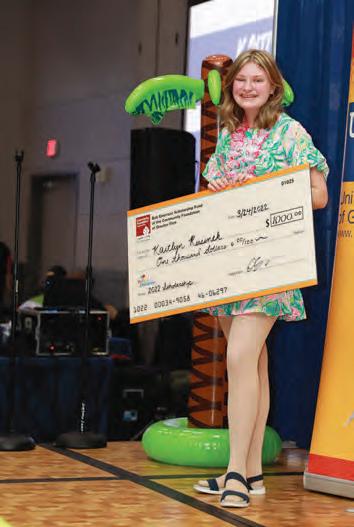









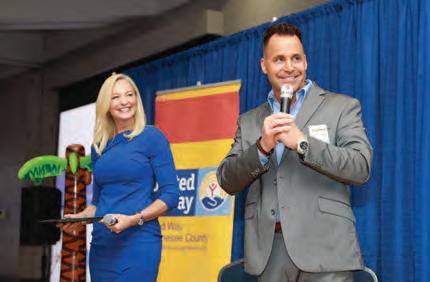


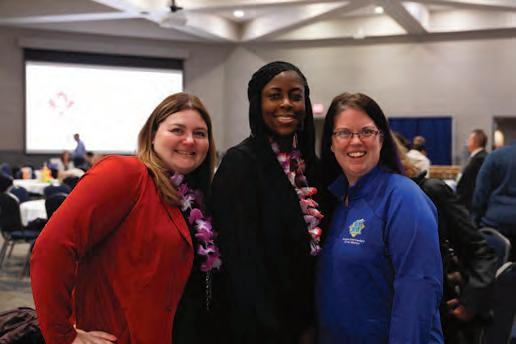







FLINT INSTITUTE OF ARTS ® 4.2.2022
The Flint Institute of Arts and Communities First, Inc., co-hosted a celebration of “Sons: Seeing the Modern African American Male” by Flint by artist and photographer, Jerry Taliaferro. The exhibition features photographs of 49 men from Flint. The event began with a discussion with Taliaferro, followed by a strolling buffet catered by Redwood Lodge and live entertainment provided by Reichlin Small Group. Proceeds support FIA exhibitions and expansion of the museum’s collection of African American art.

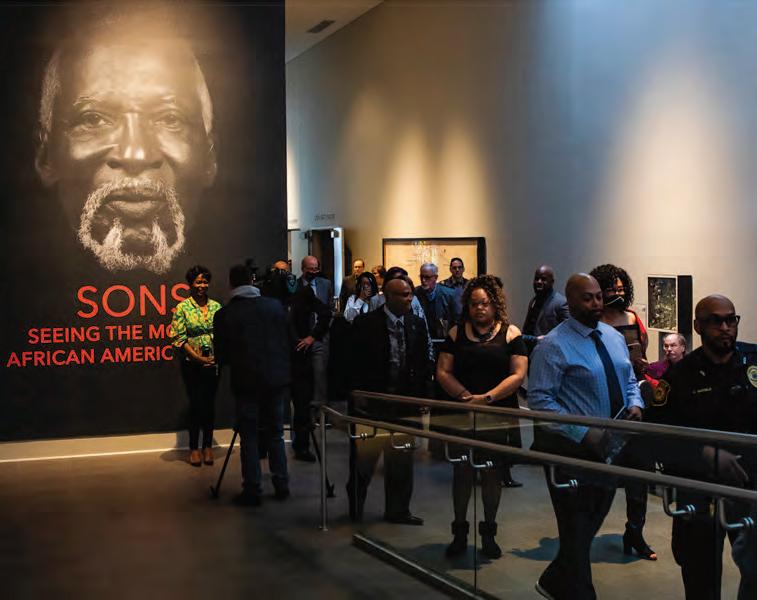







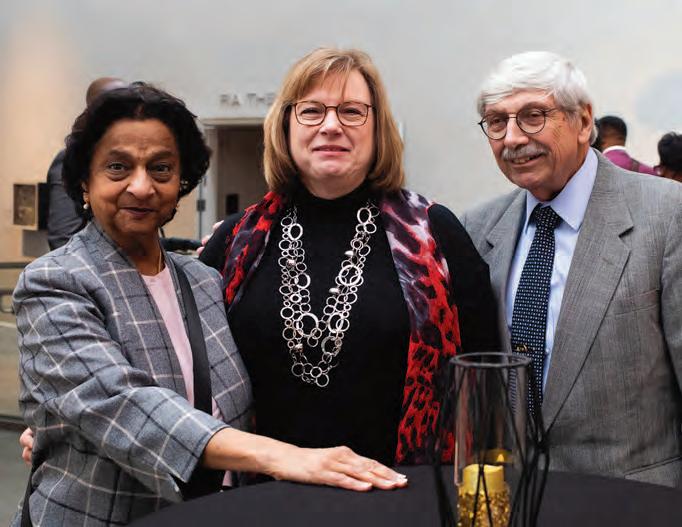































BY VERA HOGAN
Mother’s Day has always been one of my favorite holidays, when my sons show their love and appreciation for me in special ways. It’s a day when I know how truly blessed I am.
As much as I love this day, my heart goes out to our sisters struggling in Ukraine on this Mother’s Day. ose mothers are warriors. e unspeakable pain and horrors they have faced and sacri ces they have made to survive are unimaginable.
When my boys were little, I had the luxury of putting nice warm jammies on them, freshly-bathed, tucking them into bed each night with a story and lots of giggling and kisses before lights-out. Never in my wildest, worst nightmares could I imagine my family being attacked by missiles overnight and having to explain to my children why someone was trying to kill us. e fear would be overwhelming.
I can’t imagine having my little ones carry a backpack containing a change of clothes, a few snacks and one toy, leaving the comfort of our home to sleep in a cold, underground shelter. en, hop on several packed trains and later walk miles and miles in the freezing cold until we’re ready to drop, to seek safety in another country, like Poland – a strange place where they don’t speak our language.
Bless the people of Poland, who at this writing had welcomed about two million refugees from Ukraine – women and their children with nowhere else to go. And they don’t call them refugees; the Polish refer to them as “guests.” I am very familiar with the Polish community in this country. Believe me, mamas in Poland will without question treat the Ukraine children as their own. ey will eventually be okay.
I would also like to acknowledge the mothers in Russia. It is estimated that more than 10,000 of their

sons (troops) died in this unprovoked war. I recently saw a picture of a very young Russian soldier in uniform, with tears in his reddened eyes. He asked his mother why he had to ght and maybe die in a war started by a crazy, old, power-hungry man. Why, indeed?
Imagine being a mother in a poor and dangerous Central American country, making the agonizing decision to somehow get her children to the Mexican border, often traveling hundreds of miles on foot, and get them across the border alone, into America where they will hopefully be safe and lead a better life.
Imagine being a Black mother who sends her innocent young son out every day, not knowing whether he is coming home, fearing that he may be brutalized or even killed, just because he’s Black.
To all the mothers of the world, you are not alone or forgotten. We cry with you on this special day and hold you in our hearts with love. ®
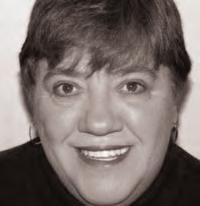
Recently retired, Vera Hogan is a 20year veteran of the newspaper business, having served both Fenton and Flint area publications. During those years, she was a reporter, associate editor, editor, web content editor and columnist. Her popular columns have earned her multiple state awards. She resides in the City of Fenton. Email verahogan@hotmail.com.



BY LESLIE TOLDO
AsI lay on my couch in a sinus infection stupor, my husband blasted through the back door, shouting, “Call the police! Lucy is missing!”
I sat up, stunned and not quite certain I’d heard him correctly. Lost? How can Lucy possibly be lost? My husband was in the yard with her. We have an electric fence for Pete’s sake! en, reality started to sink in. We are talking about Lucy here. Lucy is your typical sweet, boisterous Golden Retriever. Loud noises terrify her ... the electric fence, not so much.
I called the Linden Police non-emergency phone number and left a frantic message that, after I hung up, replayed in my mind like a whole lot of crazy.
Suddenly, I felt a little out of my mind. Where could she be? Does someone have her?
“What do I do now?” I shouted out to my empty house. en, it hit me. I needed pictures. Facebook! ere are pages on Facebook where people post their lost pets. I posted a photo on “For the Love of Louie,” “Genesee County Animal ‘911’ Responders” and on my own page. I started looking through the pictures of missing pets, feeling increasingly more helpless.
“I can’t just sit here and wait,” I thought, running to my back door.
My husband was standing in the backyard, crying. “I’ve been everywhere. I can’t nd her,” he said through tears. “How could I let this happen?”
As we stood staring at our empty yard our neighbor, Walley, who had been out searching for Lucy, wandered over. “You know, I bet somebody took her,” he said, “she could not have gotten that far.”
“NOT HELPFUL!” my husband roared.
Helpful or not, that seed was planted in my mind. A wave of

terror poured over me. If someone took her, it doesn’t matter that she’s wearing an I.D. tag and has a microchip.
According to the American Veterinary Medical Association, more than 50 percent of microchipped lost pets make it home. But, what if they are stolen?
I pictured a van load of unsavory characters swiping Lucy out of my yard. I Googled “stolen pets.” BAD idea. Petfbi.org reports two million pets are stolen every year – a total of ten million go missing altogether.
Still in my pajamas, I grabbed my car keys and decided I would go to the police department. Just as I opened my car door, I heard my neighbor George exclaim, “Leslie! Leslie! I found her!”
ere she was. Lucy had not fallen prey to a nefarious dog theft ring. Nope. She had wandered into my neighbor’s garage and gone to sleep.
She seemed a little confused about all of the fuss, but reveled in the attention she was getting from my husband and me.
As horrible as those two hours were, I learned some things that day.
First of all, never Google what the worst case scenario could be when you are in a crisis. Most importantly, though, I learned that when your pet is missing, people want to help you nd it. While I Googled and obsessed about the most horrible possible outcomes, neighbors were out scouring the streets looking for the sweet lost dog who was happily napping and safe. ®

An Emmy-nominated anchor/meteorologist/reporter at FOX66 and NBC25, Leslie Toldo has worked in TV news for over 30 years, nearly 20 in Flint. She is a blogger, writer, wedding and funeral officiant. Born and raised in Baton Rouge, LA, she graduated from the University of Wyoming. An avid kayaker, boater and runner, Leslie lives in Linden with her husband, Ellie the cat and three dogs: Bear, Gus and Lucy.








The Strategic Petroleum Reserve (SPR) was included in the 1975 Energy Policy and Conservation Act and intended to hold up to 700 million barrels of oil in the event of an emergency. e SPR was created following the 1973 Middle East Oil Embargo, when the price of crude oil tripled over six months, leading to a severe economic recession. e SPR is supposed to bu er against such disruptions that might otherwise lead to an economic or national security emergency.
On March 31, President Biden announced that one million barrels of oil would be released from the SPR per day for six months to help o set the rising oil and gasoline prices resulting from the Ukrainian War. e price of a barrel of crude oil had increased from $73.91 on Christmas Eve to a high of $133.18 on March 8. A rule of thumb is that every $10/barrel increase in the price of oil increases the price of gas by about $0.25/gallon. Consequently, the average price of gas in the U.S. increased from $3.38/gallon around Christmas to $4.33/gallon by the end of March. Unfortunately, releasing oil from the SPR will have minimal e ect on oil and gasoline prices. e U.S. consumes approximately 20 million barrels of oil/day
while producing 12 million barrels/day. Russia is the world’s third largest oil producer, producing 10.5 million barrels/day. Total world oil production is nearly 90 million barrels/day. us, the oil released by the SPR represents 5% of U.S. daily oil consumption, 1.1% of daily world production and 9.5% of daily Russian production. us, oil released from the SPR does not signi cantly displace lost oil production due to the war. e price of crude oil had already begun falling a week prior to the announcement of the SPR oil release, with the price settling around $108/barrel. e price did not further fall after the release was announced, illustrating the minimal impact the SPR has on the price of oil. Consequently, gasoline remains around $4.09/gallon in the Flint area, which is what its price has been since the war began.
Releasing oil from the SPR is a symbolic gesture for elected o cials to appear to be “doing something” in the face of voter pushback due to rising oil and gas prices. Given that gasoline is a necessity with few substitutes, consumers are largely stuck paying the higher price.
Consequently, every president since George H.W. Bush has ordered an SPR release, all with minimal impact on prices. is is an expensive gesture, as the 180 million barrels that will be released from the SPR over the next six months will have to be replaced. At $100/ barrel, replacing this oil in the SPR will cost the federal government $18 billion, or $70 for every adult in the U.S., far more than what they are saving at the pump. e only thing that will bring permanent relief is a lasting peace agreement between Russia and Ukraine. ®

Dr. Christopher Douglas came to the University of Michigan-Flint in 2006. He earned a B.S. in Electrical Engineering and a B.S. in Economics from Michigan Technological University in 2001, and his Ph.D. in Economics from Michigan State University in 2007. As Associate Professor and Chair of the Department of Economics, he teaches Principles of Microeconomics, Principles of Macroeconomics, International Economics, Public Finance, and Sports Economics.




BY JOEL P. LAGORE CFP® AIF®
Onan April 12 podcast by Goldman Sachs called “Rising Stag ation Risks Are Changing the Investment Climate’’ their global head of asset solution stated, “I would say that the playbook for investments and portfolio construction, of the period since the nancial crisis, may not be relevant anymore. We have entered a period of higher ination, higher volatility, and more uncertainty.” To say that the rst quarter of the year was challenging for investors would be a massive understatement! At the time of this writing, the NASDAQ Index is -14.66%* the S&P 500 is -7.84% and if you think that is bad, the Russian index is -36% followed by China’s Shanghai index slightly better at -11.77%.**
ose types of returns and that type of volatility can happen in equity markets and often does; but much more concerning to me was bond performance during that time period. Bonds, as measured by the ETF AGG - ishares Core U.S. Aggregate Index had a -8.89% principal rate of return since the beginning of the year. For almost the past 40 years, bonds have been a great way for investors to diversify their portfolios and avoid being completely exposed to the see-saw moves of the stock market. I have often heard people say, “when stocks go down, bonds go up –that’s why you need to have some bonds in your portfolio.”
ere is a possibility that what investors thought of as a relatively safe investment class has just ended its 40-year historic run in valuation. is is very concerning to say the least! Many older investors have stuck to the old rule of thumb, “Whatever your age is, that’s how much of your portfolio you should allocate to bonds.” Well, I believe the problem with
that is when you get up to age 75 and 80 years old, it could end up giving you massive exposure to bonds, and in so doing, you could expose yourself and your money to interest rate risk (the risk that rising interest rates may have on your current bonds). As interest rates rise, bond prices decrease in value. e opposite also holds true; if interest rates fall, bond prices go higher. is relationship between interest rates and bond prices is said to have an inverse correlation. Interest rates, although varying over time, have been falling ever since their peak in 1981.* Essentially, bond prices have had a natural tailwind. As interest rates continued to fall, bond values naturally increased, as new investors were willing to pay a premium to own the high interest rate bonds. In fact, for the rst time in U.S. history, the Federal Reserve instituted a Corporate Bond Purchasing Program to ensure that we didn’t have a “run on the bank” when it came to corporate bond prices. e Fed stopped its $6 trillion bond-buying program “Quantitative Easing” on March 9, 2022. A mixture of rising in ation and rising interest rates in an attempt to curb that in ation could have some bond investors selling their shares and heading for the hills.
I’m encouraging MCM readers who own investments to meet with their nancial advisors to discuss the impact rising interest rates will have on their portfolios. ere is a possibility that the longest bond market bull run we have seen in the modern era may have just ended. If that is true, conservative investors should consider restructuring their thought process regarding risk management. Another thing to consider is that as the Fed raises interest rates, the economy tends to slow down, and if they happen to raise rates too aggressively, I believe it could lead to a slowing economy and a decline in stock prices.
Bonds as well as stocks went down a considerable amount in the rst quarter; I believe now is a great time to assess your risk exposure. ®
*marketwatch.com/investing/index/comp **bloomberg.com/quote/SHCOMP:IND

Joel P. LaGore, Certified Financial Planner and partner with OLV Investment Group, focuses on money management. Joining the Downtown Flint revitalization effort, his office is located in The Durant at 607 E. Second Ave., Suite 100. Joel and his wife Sonya are raising two daughters in Flushing, where he enjoys philanthropic pursuits in his local community, in Flint at large and in Genesee County.








BY CHERYL DENNISON
When my daughter Melissa found out her son (my grandson) Mack had decided to join the United States Marine Corps, her life was forever changed. He had just turned 18 and hadn’t yet graduated from high school when he made the commitment. e two have always shared a special bond but no matter what Melissa said or did, Mack’s mind was made up. He told her it was his calling and something he felt compelled to do. His desire was to serve his country and in his words, is “an honorable thing to do.”
Initially, Mack was to leave for boot camp this summer, in July. However, the date was changed and he is now leaving on May 8: Mother’s Day. Not only is my daughter making the sacri ce of turning her son over to the Marines, he will board a plane to Paris Island, SC on the day we honor and cherish mothers. For Melissa, a mom to four boys, Mother’s Day will be bittersweet from now on.
While Melissa has had a few months to adjust to the idea, her heart has been lled with sadness. e little boy she nurtured and loved has become a man who will go out into the uncertainty of the world – a world over which she has no control.
To her, it seems like yesterday that Mack was a sweet little boy learning to tie his shoes and making his way in the scary world of elementary school. She watched him grow into a young man who loved everything about nature, who hunted, shed and kayaked. She cheered him on as he played junior hockey and competed on his
school’s wrestling team. She cried with him when his rst girlfriend broke his heart. She was and always will be his biggest cheerleader.
One evening as I was talking to Melissa on the phone, she just started crying out of the blue. “I’m trying so hard to be strong,” she sobbed. “I am just so sad and I don’t know what to do.” I told her that instead of being sad, she should just try to truly enjoy the time she has with Mack before he leaves.
And, that is what she has done. ey took a mother-and-son road trip to the U.P. so Mack could spend time with his older brother Brennan, who is a student at Michigan Technical University. She took a sunny afternoon o work and went shing with him. Together, she and I are planning a combined graduation and send-o party, so Mack’s family and friends can wish him well and say goodbye. ere is a song that perfectly describes how Melissa is feeling about Mack leaving to begin his military service. e song, “ is Mother’s Love” by Jill Miller was written as a tribute to Miller’s son when he joined the Marine Corps. In her song, she shares exactly how my daughter is feeling:
“Now you are o to chase your dreams. To become a man and be a Marine. And Lord, it scares me so much. Take my love with you. May it be the rock you can hold on to. No matter where we are, we will never really be apart. You will have a heart full of love. is mother’s love.” ®












BY ALEXANDRIA NOLAN
One of the best things about living in Houston, TX is being within driving distance of New Orleans. And one of the worst things is being within driving distance from New Orleans. It’s just close enough to drive to, but far enough that the drive is tedious and taxing.
During this past Spring Break, we decided upon an expedition to the Crescent City, thinking of drinking some hurricanes, eating jambalaya and as much gumbo as our poor stomachs could hold. It was after Mardi Gras and so less crowded, and noticeably not an especially popular destination for Spring Breakers, there being no beach on which to obtain a bronzing.
We stayed in the French Quarter, right in the middle of the action and yet, it was action we had wished to avoid. And, once again, the addition of a toddler to our party made our typical New Orleans explorations less exciting. Haunted ghost tours were o the table as that would tax the attention span of so small a person. Late night champagne bars were obviously a no-no, as well. Pretty much any activity that takes place after 9pm – the most exciting time in the Big Easy – was out; so instead, we were forced to experience the city more ... soberly.
And what a nice surprise! e city is vibrant in the early morning – brightly-colored shotgun houses, creole townhomes
and creole cottages, gorgeous, twisting wrought iron snaking from one balcony to the next. e city is mostly asleep at this time of day, the echoes of drunken revelers still reverberating down Royal and Bourbon Streets. Somehow, there is already a line forming at the Gumbo Shop. e souvenir shops are in full swing and while tourists thumb through all manner of cheap tchotchkes, there is a softer rhythm to New Orleans at this time of day, when the sun is soft and the day still young.
We take the streetcar from Canal to the Garden District. We meander among the wedding cake castle-like houses, some painted cheerful blues and yellows. Mardi Gras beads still dangle haphazardly from telephone lines and any surface they can be attached to, all recalling past merriment we missed.
We grab lunch from a small place that looks to be mostly frequented by locals. It is nothing special on the inside, slightly grubby and nondescript, but this only lends character; the sounds of laughter and glasses hitting tables add to the atmosphere. e gumbo and etou ee are simply made, no extra pizzazz or modern takes on the classic. And yet, they are of course delicious, and the drinks are cold and invigorating in a way that only a hot day spent exploring can inspire.
It is mid-afternoon now and too much walking while carrying a child, the sun overhead and the heavy lunch make us drowsy. e streetcar back to the French Quarter rings its bell merrily and we watch the city pass us by out the window.
By the time we are back at the hotel resting from our day’s excursion, we are hesitant to head back out at all. e sun is dipping downward, the city is stirring, growing more raucous as the minutes tick by. e voices below become louder with drink and we dutifully square our shoulders and head back out for dinner.
e food is wonderful, as is expected anywhere in New Orleans. Perhaps it isn’t only that we have a small child with us, but rather that we’re older; because as soon as the last dregs of wine are drunk from our glasses, we are ready to venture back to the hotel and relax. A few days of this and we head back on that long car trip home, wondering when we got so boring – and why we don’t mind it at all. ®

Alexandria Nolan is a misplaced Michigander living in Houston, TX with her husband, three pets and toddler son. She is a published author and contributor to various online and print publications, including a lifestyle blog, AlexandriaNolan.com. When not writing, she is reading, traveling, or reading about traveling.









“Sanctified”
The New McCree Theatre
5.5-21.2022
The Kentucky Derby Affair
Flint Institute of Arts
5.7.2022
Hurley Benefit Ball
Signature Chop House, Flushing

5.7.2022

FSPA Presents: Festival of Dance UM-Flint Theatre
5.14-15.2022
Tux & Tennies Gala and Auction
Randy Wise Motorcars, Grand Blanc
5.21.2022

Flint AFC vs. AFC Ann Arbor
Atwood Stadium
5.7.2022
Smile Empty Soul
The Machine Shop
5.12.2022
Flint AFC vs. Indy Eleven FC
Atwood Stadium
5.12.2022
“Disaster!”
Flint Community Players
5.12-22.2022
KTK Presents: “Annie, Jr.”
80s Prom with Ironsnake The Machine Shop 5.21.2022

Fenton Village Playhouse Theatre
5.13-29.2022
FSO Presents: Stravinsky’s Firebird Suite The Whiting
5.14.2022
Flint United vs. Toledo Glass City
Dort Financial Center 5.14.2022
Classic Rock City featuring Mick Adams & The Stones
The Capitol Theatre 5.21.2022
Flint City Bucks vs. Lansing City FC
Atwood Stadium
5.21.2022
Dust ‘em Off Car Show
Dort Financial Center
5.22.2022
Flint United vs. Cincinnati Warriors

Dort Financial Center
5.22.2022
Flint City Bucks vs. Kalamazoo FC
Atwood Stadium
5.28.2022
See you there!

















IMAGINE if you will a city down on its luck – holding on to the grand days of its past when parades fi lled the streets with cheer and every hand was full, now left forgotten, abandoned by prosperity to fend for itself. For the people in this city and its hard streets, hope is hard to come by, a catastrophe seemingly waiting around every corner. Now cue a movement, a feeling, a breath of fresh air full of inspiration and the world begins to change. The flowers grow, the children learn and the sun shines highlighting a path to a new horizon, a new destiny. What happens when a community walks that path together? Come with me on a voyage through another dimension – a dimension of sight, a dimension of sound, a dimension of mind. A voyage to a place without prejudice, fear or poverty. Follow me to a place of happiness and redemption and take a walk down the brick streets of … The Twilight Zone.





Ananthology TV series created by writer and producer Rod Serling, “The Twilight Zone” o ered science ction, horror, suspense, comedy and more. It rst aired on October 2, 1959 and ran for ve seasons, a total of 156 episodes. A movie was lmed in 1983 and the series was revived for three seasons in 1985. At the time of its airing, the show caught the imagination of the nation’s viewers and afterward influenced countless stories, shows and movies. Its progressive messages and fearless narratives stood out amongst its competition. Each episode dared to tell the truth about human nature and all its fallibilities
while holding viewers in suspense as they awaited the famous “plot twist.”




The series is regarded as one of the best of all time and today, is still enjoyed by new generations of fans. So, in honor of the great Rod Serling and his groundbreaking creation, take the time on May 11 to contemplate and build a new dimension outside your own. Take a chance you never before dared to, speak to someone new, try a different style, do something unfamiliar and open a door to your own … Twilight Zone. ®





















